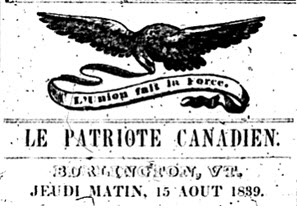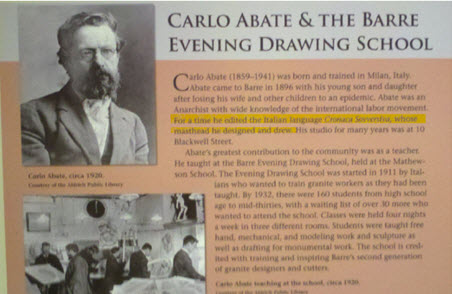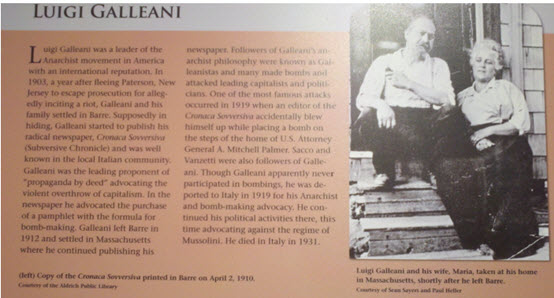All posts by VTDNP
VTDNP Interactive Map
After completing a short course on spatial literacy and online mapping, Prudence Doherty of the VTDNP project management group was inspired to create an interactive map that provides access to the newspaper titles digitized during the first phase of the project. A version of the map will soon be added to the VTDNP web site, but for now, try the one below.
It’s simple to use. First, click on an icon to get a list of newspapers from that location. Then click on a title to get access to the digitized content. You can also start by selecting “View Larger Map” at the bottom left corner of the map.
PBS documentary, The Abolitionists, and a headline from Vermont
The Abolitionists has been airing this month in three parts on PBS’ American Experience series – Tuesdays, January 8th, 15th, and 22nd, 2013 from 9-10.
The Abolitionists is a fascinating documentary that features extracts from many archives and yes, many newspaper headlines and articles. These primary resource materials from the nineteenth century figure prominently.
You can watch The Abolitionists on your local Public Television station.
The Vermont Public Television (VPT) schedule is listed here: https://www.vpt.org/show/19661/101
You can also view it online:
https://video.pbs.org/video/2323777396
The National Endowment for the Humanities provided major funding for The Abolitionists. The Library of Congress and its Chronicling America website, and numerous other archival and cultural heritage organizations contributed to the development and creation of The Abolitionists.
In August 2012, the VTDNP was contacted by Tiffany Hagger – one of the researchers working on The Abolitionists. She wrote to request a high resolution image of a page containing the newspaper article “California and Slavery”from the Burlington Free Press, Mar. 1, 1850 (p.2) to use in the documentary. She had discovered the article on the Chronicling America website. VTDNP was pleased to play a small role in contributing this image for inclusion in The Abolitionists.
If viewing The Abolitionists on the Internet or on the DVD, you can use the time or chapter index feature to see the Burlington Free Press “California and Slavery” headline that begins “Chapter 12 – The Great Compromise,” – at approximately 1:25 into the video. The camera lingers on the Burlington Free Press banner and article headline “California and Slavery,” and then scrolls down to zoom in on the text, “the Union is not worth preserving” while a voice-over introduces the question of territories acquired after the Mexican-American War and the debate surrounding California joining the union as a free state, along with other circumstances leading to the “Great Compromise” of 1850.
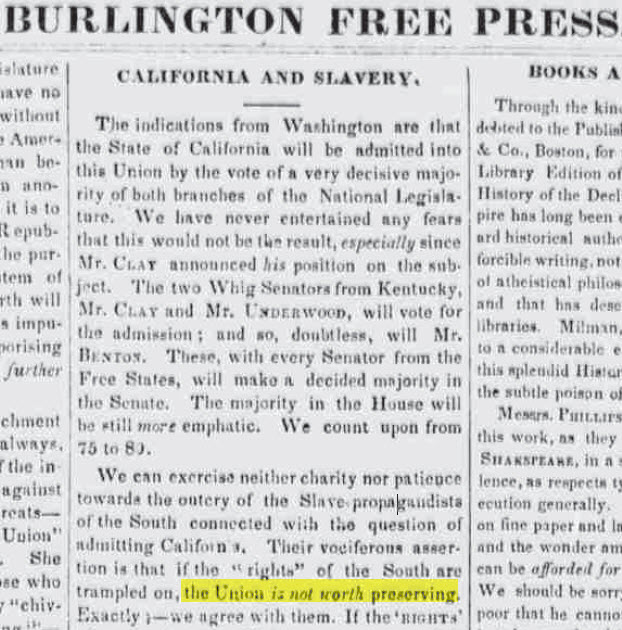
You can read the complete full-text to the article on Chronicling America: https://chroniclingamerica.loc.gov/lccn/sn84023127/1850-03-01/ed-1/seq-2/
And don’t forget to watch The Abolitionists !
It is a compelling and well-done documentary, and part of our nation’s history.
– Birdie MacLennan
Historic French and Italian Newspapers in Vermont
In addition to newspapers in geographical areas not covered under Phase 1, as well as anti-slavery titles, the VTDNP Phase 2 grant proposal emphasizes Italian language and French language newspapers from historically important immigrant populations in Vermont. This article features information about French and Italian newspapers that were published in Vermont in the 19th- and early 20th century to be included in the Phase 2 digitization effort.
In August, with Phase 2 planning underway, Tom McMurdo and Birdie MacLennan traveled to the Aldrich Public Library in Barre and to the Department of Libraries in Montpelier to research information about existing master negatives for Italian and French language newspapers in our database, notably these two historically weeklies: Le Patriote canadien, the first French-language newspaper published in New England, and Cronaca sovversiva, Luigi Galleani’s anarchist newspaper, which started in Barre and was published there for nearly a decade.
In Montpelier, we examined service copies of Le Patriote canadien, published from 1839 to 1840 by the well-known French-Canadian printer and journalist, Ludger Duvernay.
Upon further investigation, we discovered that the University of Vermont holds the master negative for this title. Duvernay came to Vermont in the wake of the 1837-1838 Patriot Rebellion of Lower Canada. A printer by profession, he published a number of newspapers, including the Gazette des Trois-Rivières and La Minerve which supported the Parti Patriote and Louis-Joseph Papineau in the years leading up to the Rebellion. On November 16, 1837, facing an arrest warrant, his printing office was sacked and he was forced to flee. Duvernay was appointed officer of a small Patriote battalion and, on December 6, 1837, took part in the Battle of Moore’s Corner, near Saint-Armand, along the border with Vermont. Defeated, he took refuge in Vermont.
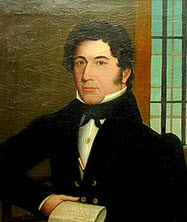
Duvernay found a more liberal environment in Burlington for expressing his views of the injustices of the regime in Canada. In 1839, in Burlington, he launched Le Patriote canadien to rekindle the flame of the Patriot refugees. However, he also treats the local scene and includes events of interest about the Burlington area. Le Patriote canadien is recognized as the first French-language newspaper to be published in New England. It also includes translations and texts in English.

At the Aldrich Public Library in Barre, we met with Library Director, Karen Lane, and researched master microfilm availability for Italian-language newspapers published in Barre. The granite industry, centered in the Barre area, attracted waves of Italian immigrants to the state and at the turn of the century, there were eight Italian-language newspapers published in Barre. The upshot of the Barre meeting is that we have been able to locate master microfilm availability for two important newspapers with Italian language content: the master negatives for the Barre Evening Telegram are available at the VSARA. This newspaper briefly published an Italian section (“Parte Italiana”) from December 27, 1898 to January 2, 1899, until the section was discontinued (presumably because of anarchist sentiments expressed by the editor). Much of our discussion with Ms. Lane focused on the high level of historical interest in Luigi Galleani’s anarchist publication, Cronaca so!
vversiva (1903-1920) which originated in Barre and reported such news as Emma Goldman’s lectures in Barre and activities of the Industrial Workers of the World (IWW or Wobblies). Initial examination of the service copies indicated a trail to a microfilming agency in the Netherlands. However, further correspondence in the wake of our visit led to Ms. Lane putting us in contact with scholar Robert D’Atilio, in Medford, Massachusetts, who had donated print copies of the Cronaca to the Boston Public Library in the 1970s for microfilming. Tom subsequently contacted Chrissy Rissmeyer, Digital Projects Coordinator at the Boston Public Library (BPL), to inquire about availability of the master negatives, and found that the BPL does indeed have the complete run of negatives for the Cronaca and that they would be willing to loan the negatives to the VTDNP for digitization under the NDNP.
The VTDNP interest in the Cronaca dates back to August 2010, following press releases about the NEH award for Phase 1 of the VTDNP. At this time, Karen Lane contacted Project Management Group member Lorraine Lanius at the State Library to advocate for digitization of the Cronaca: “Since coming to Barre in 1977, I have been aware of the rich ethnic diversity of the community and the keen interest of scholars worldwide in the six or seven Italian-language newspapers that were published here. By far the most significant of these is the Cronaca sovversiva and its perennial value and interest to researchers has always impressed me. Cronaca sovversiva is described by Dirk Hoerder in his annotated bibliography, The Immigrant Labor Press in North America, 1840s – 1970s (NY: Greenwood Press, 1987) as having had a ‘very strong influence on the Italian-American anarchists,’ of whom there was a large continent in Barre in the early 20th century!
. Its editor, Luigi Galleani, was the leading Italian anarchist of his day, a man who continues to inspire scholarly research a full century later. Please see Paul Heller’s excellent article on Luigi Galleani and the Cronaca Sovversiva in the Times Argus: https://www.timesargus.com/article/20100430/THISJUSTIN/100429957.”
We gratefully acknowledge Karen Lane’s interest in seeing Vermont’s Italian language content and heritage represented in Chronicling America. We are also very grateful to Chrissy Rissmeyer and her colleagues at the BPL, including Henry F. Scannell and Tom Blake, for their gracious collaboration in our quest for the negatives.

tributed by Carlo Abate, the Barre artist who devoted his life to art, political thought, and progressive deeds. Abate was listed as the publisher of the Cronaca, a ruse to conceal the identity of Galleani, who was wanted by the police…. Abate’s masthead was used throughout the Cronaca’s publishing life.” – Paul Heller, Granite City Tales, p. 3-34.
About Carlo Abate and Luigi Galleani – photos from an exhibit at the
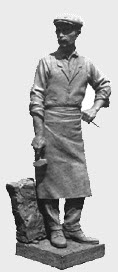
Heritage Gallery, Vermont History Center, The Emergence of the Granite City: Barre 1880 to 1940. During the period covered by the exhibit, Barre’s population increased from 2,206 to 11,855 in less than fifteen years, and it became known as the granite center of the world. Mark Hudson, Executive Director of the Vermont Historical Society, notes that, “In addition to their diverse customs and languages, many of the new residents also had political beliefs that contrasted with the natives. With immigrant populations from French-Canada, Scotland, Italy and many other European countries, Barre became a cosmopolitan city distinct from others in Vermont.”
https://www.vermonthistory.org/index.php/vermont-heritage-gallery.html
See also:
Woodsmoke Productions and Vermont Historical Society, “Anarchist Movement in Barre,” The Green Mountain Chronicles radio broadcast and background information, original broadcast 1988-89, accessed on the web at https://vermonthistory.org/index.php/anarchist-barre.html.
– Birdie MacLennan
Farewell!
-----Original Message----- From: NEH-LC National Digital Newpaper Program - On Behalf Of Tom McMurdo Sent: Tuesday, November 06, 2012 11:05 AM Subject: [NDNP] Farewell!
Hi all,
Today is my final day as Project Librarian for the Vermont Digital Newspaper Project. I am moving just down the road to become Head of Technical Services at the Vermont State Library in Montpelier, VT. For most of the last 12 years I have been part of either the USNP, NDNP, or both. For the last two years I have been here in VT, and before that I was part of the CDNC at Berkeley, and the California Newspaper Project at Berkeley and Riverside. While I will miss my daily encounters with historical newspapers and microfilm, I won’t miss those anxious months between grant applications and approvals. This new position is a great opportunity and I am really looking forward to it. That said, I will miss being part of this dynamic project as part of my day to day work. Fortunately, my new position has a historical role as an adviser for the VTDNP, so I will still have a degree of involvement in the Project.
I have greatly enjoyed being part!
of the NDNP community and I look forward to seeing more states join and witnessing the growth of more homegrown state historical newspaper digitization projects.
My best to all of you,
Tom
—
Tom McMurdo
Project Librarian
Vermont Digital Newspaper Project
Bailey / Howe Library
University of Vermont
538 Main Street
Burlington, VT 05405


